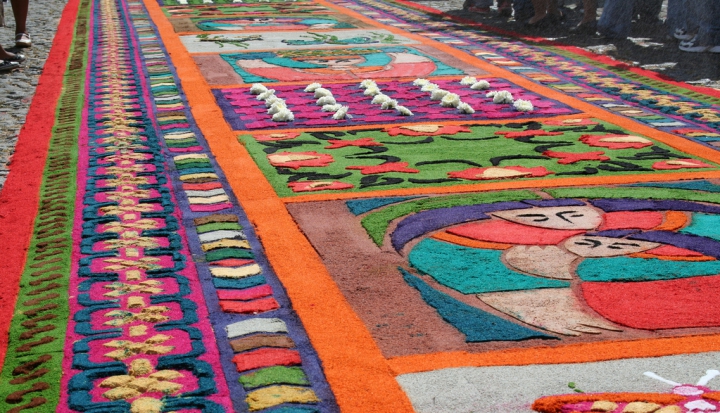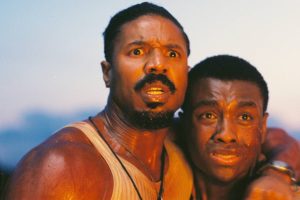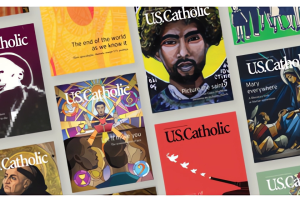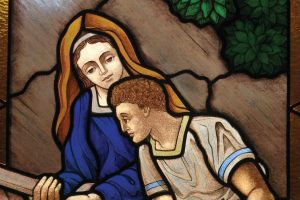It’s Good Friday—viernes santo—and we are walking. The liturgy moves from the parish church, with its adobe walls, concrete floor, and corrugated zinc roof, out into the rocky, unpaved streets of Cusmapa, Nicaragua. The corpus is taken down from the cross and laid in a casket, borne on the shoulders of six men who lead a procession out the door. It’s unlike any Holy Week I’ve ever experienced in the United States, where the liturgies remain firmly contained in the four walls of the sanctuary. Today, we are literally the people of God on a journey—el pueblo de Dios en camino.
Good Friday, viernes santo, and we are walking. Mothers carry infants in their arms or hold the hands of small children. Indigenous-faced elders—viejitos and viejitas—walk with canes or crutches alongside members of the high school youth group. People come out of their homes to join the procession and are trailed by neighborhood dogs and even a few chickens. Night falls, but the moon has yet to rise. The only light comes from a few streetlights and two large pillar candles, carried by men on either side of the casket.
We sing as we walk: “Piedad, Senor, piedad…mercy, Lord, mercy…if our sins our great, Your goodness is greater.” Somewhere in the procession, Don Agustín plays minor chords on a guitar, though its sound is nearly drowned out by the strong, plaintive voice of the campesina woman behind me. She sings from a deep place; like many in Cusmapa, she has buried children and grandchildren, lost to the violence of the Contra war and to the violence of extreme poverty. She is no stranger to the mystery of the cross. As we walk and sing, I can’t tell where my voice stops and her voice begins.
Good Friday, viernes santo, and we are walking. We make our way along in the dark the best we can, occasionally bumping into a neighbor or stepping on someone’s heel. On my feet are blue rubber chinelas, which I purchased at an all-purpose store in Estelí for two dollars. They offer little traction. As we turn a corner and make our way down the steep hill beside Chico Jirón’s house, my feet falter on the loose gravel. One of my legs flies forward and I narrowly miss kicking the person in front of me.
Immediately and wordlessly, those beside me grip my arms and shoulders to steady me. Without being able to see, I again feel the ground beneath me. I shake my foot to kick out the pieces of gravel that have gotten into my chinelas. Then, shoulder to shoulder with my neighbors, our eyes on the candlelight-illumined coffin before us, we continue to walk and to sing of the God’s overwhelming goodness and our need for God’s mercy.
It’s not unlike being carried by ocean waves. We become a larger organism and those around me seem an extension of myself and I an extension of them. I don’t know that I could make my way out of the procession even if I wanted to. Somehow, my outsider status as a gringa foreigner has fallen away. I am simply just another body in the larger body of the iglesia pelegrina—the pilgrim Church.
Years later and many miles away, in Chestnut Hill, Massachusetts, I take a course in ecclesiology at Boston College. I read Lumen Gentium, Vatican II’s “Dogmatic Constitution on the Church,” which opens with a chapter on the church’s mystery and continues with a chapter on the people of God. I immediately think of the experience of that viernes santo in Cusmapa.
This is perhaps my clearest experience of the mystery of the church as people of God. It is an image of church I return to again and again: church as all of us, together, walking forward in the dark as we sing in both praise and petition. No one is excluded; all are welcome to join in the journey. Sometimes I am the strong one. Sometimes I am the one who stumbles. Our arms reach out to hold and steady each other when the ground is unstable, the lights are few, and the road is rocky and unclear. We step on each other’s feet—literally and figuratively—but we keep moving forward.
“Mercy, Lord, mercy…if our sins our great, Your goodness is greater,” we sing over and over as we process. We claim this mercy…not the mercy of a God who is abstract and distant, but of the God we find in the midst of each other on the journey.
The procession of viernes santo in Cusmapa gifted me with an enduring sense that my spiritual journey is personal but never private. Community, comunidad, is necessary for encountering the Holy—even and especially in the midst of suffering. It here that the mystery of church is incarnated: in the blending of our voices as we ask for God’s mercy and boldly claim God’s goodness, in the strength of the arms which hold others up, and in the collective forward movement of our feet.
Image: Flickr cc via Morgan C. Smith












